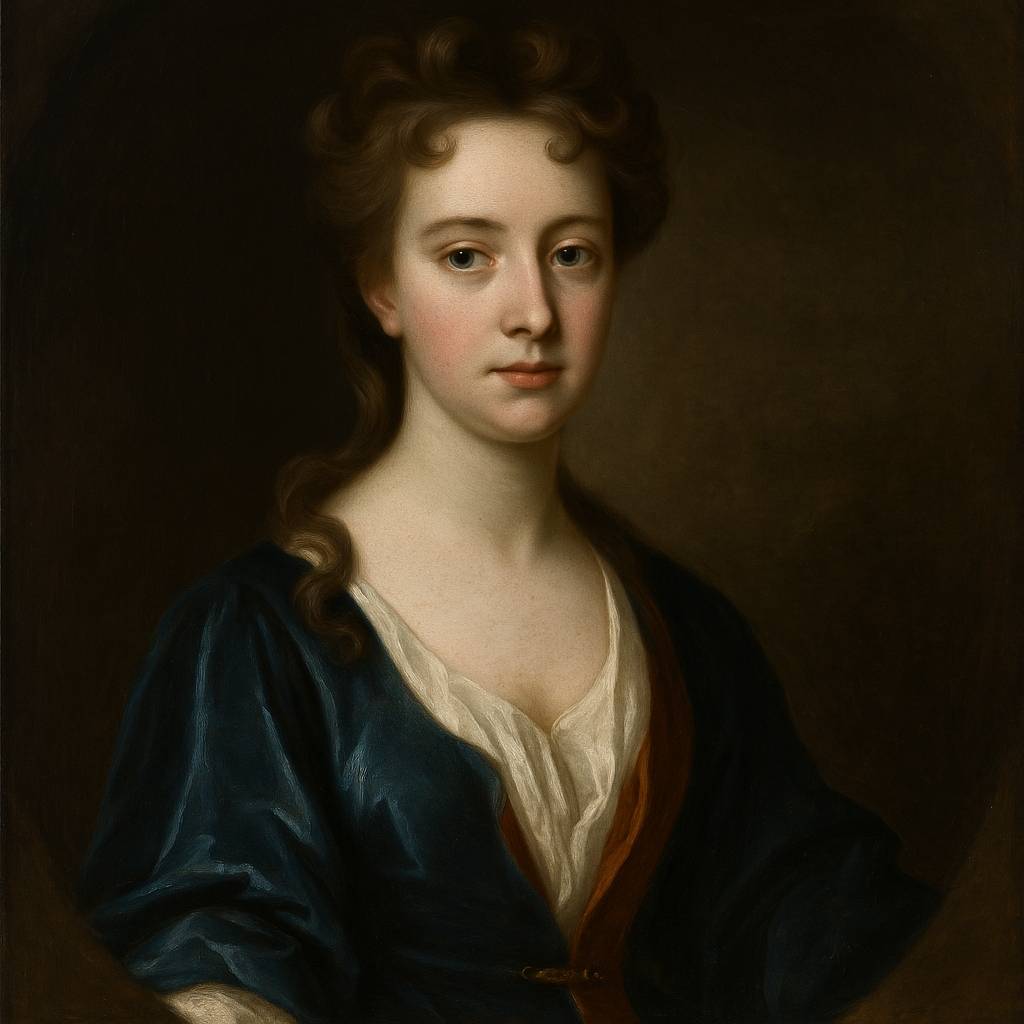Verses Written on her Death-Bed at Bath
Mary Monck
1677 to 1715

Thou, who dost all my worldly thoughts employ,
Thou pleasing source of all my earthly joy:
Thou tend'rest husband, and thou best of friends,
To thee this first, this last adieu I send.
At length the conqu'ror death asserts his right,
And will for ever veil me from thy sight.
He wooes me to him with a chearful grace;
And not one terror clouds his meagre face.
He promises a lasting rest from pain;
And shews that all life's fleeting joys are vain.
Th' eternal scenes of heav'n he sets in view,
And tells me that no other joys are true.
But love, fond love, would yet resist his pow'r;
Would fain awhile defer the parting hour:
He brings thy mourning image to my eyes,
And would obstruct my journey to the skies.
But say, thou dearest, thou unwearied friend;
Say, should'st thou grieve to see my sorrows end?
Thou know'st a painful pilgrimage I've past;
And should'st thou grieve that rest is come at last?
Rather rejoice to see me shake off life,
And die as I have liv'd, thy faithful wife.
Mary Monck's Verses Written on her Death-Bed at Bath
Introduction
Mary Monck's poignant and deeply personal poem "Verses Written on her Death-Bed at Bath" offers a profound exploration of love, mortality, and the complex emotions that arise at life's end. Composed in the early 18th century as Monck faced her imminent demise, this work stands as a testament to the enduring power of marital devotion and the human struggle to reconcile earthly attachments with the promise of spiritual transcendence. Through a careful analysis of the poem's structure, rhetorical devices, and thematic content, we can uncover the nuanced layers of meaning embedded within Monck's final literary testament.
Historical and Biographical Context
To fully appreciate the depth and significance of Monck's poem, it is essential to consider the historical and biographical context in which it was written. Mary Monck, née Molesworth, was born in 1677 to an aristocratic Anglo-Irish family. Her marriage to George Monck, a relation of the first Duke of Albemarle, placed her within the upper echelons of English society. However, it was her literary talents that truly set her apart, earning her recognition among the bluestocking circles of her time.
The poem in question was composed during the early 18th century, a period marked by significant social, cultural, and intellectual upheaval. The Enlightenment was in full swing, challenging traditional notions of faith and mortality. Simultaneously, the cult of sensibility was emerging, emphasizing emotional depth and individual experience. Monck's work, with its blend of religious conviction and personal sentiment, reflects the complex interplay of these cultural currents.
Structure and Form
Monck's poem adheres to the formal conventions of her time, employing heroic couplets—rhyming pairs of iambic pentameter lines. This choice of form is significant, as the heroic couplet was often associated with elevated subject matter and rational discourse. By adopting this structure for her deeply personal meditation on death and love, Monck imbues her intimate thoughts with a sense of universal gravitas.
The poem consists of 22 lines, forming 11 perfect couplets. This symmetry reflects a sense of completion and balance, mirroring the poet's acceptance of her fate. The regularity of the meter and rhyme scheme provides a soothing rhythmic quality, perhaps echoing the "lasting rest from pain" that death promises.
Rhetorical Devices and Poetic Technique
Monck employs a variety of rhetorical devices to convey the complexity of her emotional state. The poem opens with an apostrophe, directly addressing her beloved husband. This technique immediately establishes an intimate tone and foregrounds the centrality of their relationship to the poem's thematic concerns.
Personification plays a crucial role throughout the work. Death is portrayed not as a terrifying specter, but as a "conqu'ror" with a "chearful grace" and without "terror." This unexpected characterization serves to underscore the poet's acceptance of her fate and her belief in the promise of heavenly reward.
Antithesis is another key device employed by Monck. She juxtaposes "earthly joy" with "eternal scenes of heav'n," highlighting the tension between worldly attachments and spiritual aspirations. This contrast is further emphasized through the use of opposing imagery: the "fleeting joys" of life are set against the "lasting rest" offered by death.
The poem also makes effective use of enjambment, with thoughts and sentences flowing across line breaks. This technique creates a sense of continuity and forward momentum, mirroring the poet's journey from life to death, from earthly concerns to heavenly contemplation.
Thematic Analysis
At its core, Monck's poem grapples with the tension between earthly love and spiritual devotion. The opening lines establish the depth of the poet's affection for her husband, describing him as the source of all her "worldly thoughts" and "earthly joy." This emphasis on the physical and temporal nature of their bond sets the stage for the spiritual transformation that follows.
As the poem progresses, death is presented not as an enemy, but as a liberator. The promise of relief from pain and the revelation of life's fleeting nature suggest a growing detachment from worldly concerns. This shift in perspective aligns with Christian teachings on the transience of earthly existence and the eternal nature of the soul.
However, Monck does not present this spiritual awakening as an easy or uncomplicated process. The personification of "love, fond love" as a force that "would yet resist" death's power acknowledges the deep-seated human desire to cling to life and loved ones. This internal conflict adds depth and authenticity to the poem, reflecting the complex emotions that often accompany the dying process.
The final section of the poem introduces a persuasive element, as Monck attempts to console her husband and justify her acceptance of death. By framing her passing as an end to a "painful pilgrimage" and a fulfillment of her role as a "faithful wife," she recontextualizes death as a positive, even triumphant, event.
Feminist Interpretation
While firmly rooted in the conventions and beliefs of her time, Monck's poem can also be read through a proto-feminist lens. The very act of composing and sharing such a personal and intellectually engaged work challenges the notion of women as passive or intellectually inferior beings. Moreover, Monck's assertion of her identity as a "faithful wife" even in death suggests a reclamation and elevation of the marital role, imbuing it with spiritual significance.
The poem's negotiation between earthly love and heavenly devotion can be seen as a subtle critique of societal expectations placed on women. By ultimately choosing spiritual fulfillment over earthly attachment, Monck asserts her individual agency and spiritual autonomy.
Comparative Analysis
Monck's work invites comparison with other metaphysical and devotional poets of the 17th and early 18th centuries. The blend of intimate emotion and religious contemplation echoes the works of John Donne, while the acceptance of death as a transformative force recalls the poetry of George Herbert.
However, Monck's distinctly female perspective and the specificity of her situation—addressing her husband from her deathbed—set this poem apart. Unlike many male poets of the era who often wrote about death in abstract or hypothetical terms, Monck's work is grounded in immediate, lived experience, lending it a unique power and poignancy.
Conclusion
Mary Monck's "Verses Written on her Death-Bed at Bath" stands as a remarkable testament to the human capacity for love, spiritual growth, and acceptance in the face of mortality. Through its masterful use of form, rhetoric, and imagery, the poem offers a deeply personal yet universally resonant exploration of life's final transition.
The work's enduring power lies in its ability to capture the complex interplay of emotions that accompany death—love, fear, hope, and resignation—while ultimately affirming the poet's faith in a higher purpose. As a literary artifact, it provides valuable insight into early 18th-century attitudes toward death, marriage, and spirituality, particularly from a female perspective.
Moreover, Monck's poem serves as a poignant reminder of poetry's capacity to bridge the gap between the deeply personal and the universal, offering solace and insight to readers across centuries. In its elegant negotiation of earthly attachments and spiritual aspirations, "Verses Written on her Death-Bed at Bath" continues to speak to the fundamental human experience of grappling with mortality and the search for meaning in the face of life's ultimate transition.
This text was generated by AI and is for reference only. Learn more
Want to join the discussion? Reopen or create a unique username to comment. No personal details required!



Comments
No comments yet. Be the first to comment!